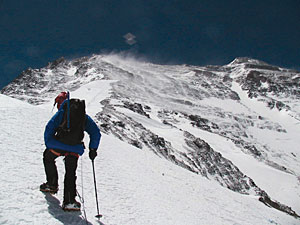 |
The onset of spring signals the start of a veritable onslaught on Everest. Gone are the days when climbing was limited to explorers and adventurers, the likes of Eric Shipton, Ed Hillary, Doug Scott, and Tenzing Sherpa. Now many climbers who aim to conquer Everest are 'office workers' affluent enough to use the services of a commercial guide to help them up the mountain.
Delving into the psychology of this new breed of climbers reveals much about human nature. Many climb out of interest and a sense of excitement. Others, however, may want to climb because of a midlife crisis. Intellectually, they may have peaked in their professions; but physically they may perceive themselves as wanting. What could be better for the morale than an Everest feather in their caps? Except these days, every Tom, Dick and Harry (and Jane and Kanchi Maya) also appear to have done Everest.
Today's climbers may not always have adequate time either. Indeed, some years ago, an elderly Japanese team (all the members of the expedition were over 55 and were senior board members) decided that they wanted to climb Everest as quickly as possible, without acclimatising the old-fashioned way. So they brought plenty of oxygen cylinders, and used supplemental oxygen right from Base Camp. They successfully ascended the mountain in just over three weeks and reported back to work in Japan a week after their climb!
The acclimatisation period, which may take about two months, demands patience. Acclimatisation means allowing the body's physiological functions to adapt to the decreased oxygen level (hypoxia) of high-altitude terrain. So climbers have to wait it out in the inhospitable Everest Base Camp or higher to acclimatise to altitude over six to eight weeks before they finally make their bid for the summit.
As Peter Hackett, altitude illness expert and Everest summiteer says, "People can live for months at 6,000m, weeks at 7,000m but only days at 8,000m." Heading to the potential 'death zone' of 8,000m you're well-advised to understand that at that altitude, the human body is unable to acclimatise further. Good luck to those who've caught Everest summit fever this spring.


